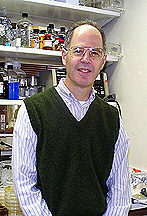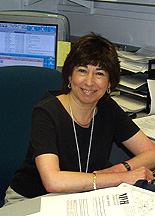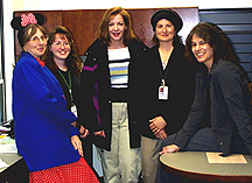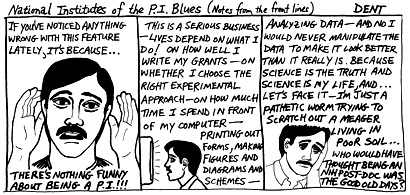| CONGRATULATIONS! | ||
 |
 |
Smile and the world smiles with you: Reed Wickner (far left)and Leslie Ungerleider are two illustrious additions this year to the National Academy of Sciences. Wickner, chief of the NIDDK Laboratory of Biochemistry and Genetics, grinned as he acknowledged, "I am very happy about this, to tell the truth." And Ungerleider, chief of the NIMH Laboratory of Brain and Cognition, happily described herself as "overwhelmed." She also noted that last year at this time, it was her husband (Robert Desimone, also at NIMH) who was elected to the Academy.
|
|
HISPANIC
SCIENTISTS: The first-ever NIH Hispanic Scientists Day, in recognition of scientific contributions by Hispanics in the NIH Intramural Program, is scheduled for Monday, June 5, 10:30 a.m.–1:00 p.m. in Building 10, Lipsett Amphitheater. The activity will begin with a seminar–"A Framework for Fc Receptor Signaling: A Complex Story"—at 10:30 a.m. by Juan Rivera, senior investigator and head of the Signal Transduction Group, Chemical Immunology Section, Arthritis and Rheumatism Branch, NIAMS. Poster presentations by Hispanic postdoctoral fellows and postbaccalureate trainees will follow from 11:30 a.m. to 1:00 p.m. The event is sponsored by the NIH Fellows Committee
and the NIH Hispanic Employee Organization. For more information,
please contact Nancy
Vazquez-Maldonado by e-mail or call at (301) 827-1774. |
CATALYTIC RELOCATIONS The NIH Catalyst has moved on! After bouncing around Building 1 since its birth in 1993, the Catalyst has finally moved into custom-made and hopefully permanent quarters in the newly reopened Building 2. Catty-cornered from Building 1, Building 2 also houses other arms of the OIR—the Office of Loan Repayment and Scholarship and the Office of Education, as well as the Office of AIDS Research and OD executive offices. We are on the second floor in rooms 2W23 and 27. Phone, fax, and e-mail remain the same. Our parallel universe has also moved—the new web address for the Catalyst is </catalyst/>. There you will find the first two issues of
the year 2000 (and by mid-June this very issue) and previous issues
that reach back to May 1994. All of 1999 is currently missing but
will magically materialize before 2001. We promise.
|
||
| METALS
IN MEDICINE
NIGMS
and several other NIH components are hosting a meeting on "Metals
in Medicine: Targets, Diagnostics, and Therapeutics," June
28—29, 2000, at the Natcher Conference Center, to explore the
role of metals in the development of therapeutic drugs and in vivo
diagnostic agents. For a printable meeting flyer and list of speakers,
topics, and registrants, visit <http://pub.nigms.nih.gov/MIM>,
where online registration is available and encouraged. For more
details, contact organizer Peter
Preusch by e-mail or call at (301) 594-5938.
|
|||
|
|

